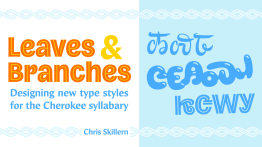Leaves & Branches: Designing New Type Styles for the Cherokee Syllabary
Monday, October 14, 2024, 12:30 - 2pm

The Cherokee syllabary, created by Sequoyah two-hundred years ago, was quickly adapted for printing upon its adoption and has since been integrated into almost every successive new technology, from typewriters to computers to smart phones. Over that period of time, however, the look of the syllabary has changed very little. Aside from one or two notable exceptions, the syllabary is still most often represented in a style similar to the original metal type. Stylistic diversity is important for the vitality of a written language, but how can we begin to approach designing new styles for a script with so few models? Type designer and Cherokee Nation citizen Chris Skillern explores the syllabary and the challenges it presents as well as shares his process when designing for the syllabary as part of the Herb Lubalin Lecture Series.
Register for the online event here.
Chris Skillern is a type designer and citizen of the Cherokee Nation from Tulsa, Oklahoma. A 15-year-long obsession with drawing type led Skillern to Type West, the Letterform Archive’s type design certificate program, in 2021, where he designed Meli, a type family inspired by his daughter, which supports the Latin alphabet and the Cherokee syllabary. Since graduating from Type West, Skillern has had the opportunity to work with foundries like A+ and XYZ Type on custom type projects for brands big and small. When not assisting other designers, he stays busy with his own foundry, Tulsey Type, which features his friendly, lively, and detailed designs for Latin and Cherokee. He is currently working with the Cherokee Nation and Typotheque on new fonts for the syllabary.




